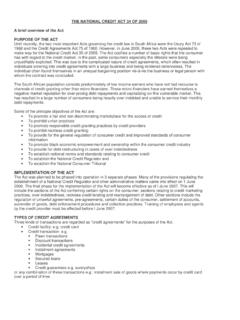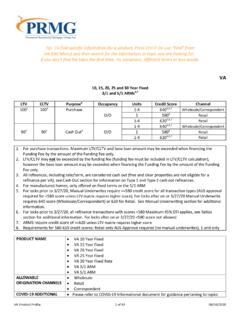Transcription of LOYALTY REBATES : AN ASSESSMENT OF COMPETITION …
1 LOYALTY REBATES : AN ASSESSMENT OF COMPETITION CONCERNS AND A.. PROPOSED RULE OF REASON. David Spector**. CNRS et PSE. Octobre 2005. Docweb n 0514.. Article paru dans COMPETITION Policy International, vol. 1 (2), Autumn 2005. **. Paris Sciences Economiques, Ecole Normale Sup rieure, 48 boulevard Jourdan, 75014 Paris. Email : Rabais de fid lit : appr ciation des probl mes de concurrence et proposition d'une r gle de raison structur e R sum : Comme la plupart des pratiques tarifaires, les rabais de fid lit peuvent, selon les circonstances, b n ficier ou nuire aux consommateurs. Cet article examine leurs justifications proconcurrentielles et anticoncurrentielles. Les conclusions principales sont les suivantes. Tout d'abord, tous les types de rabais peuvent, dans certaines circonstances, tre proconcurrentiels : il n'est donc pas justifi d'interdire a priori certaines formes de tarification consid r es comme douteuses d'un point de vue concurrentiel.
2 Mais les rabais de fid lit peuvent faciliter la mise en uvre de strat gies d'exclusion par une entreprise dominante car ils poss dent plusieurs avantages par rapport aux strat gies de prix pr dateurs classiques : ils sont moins co teux, plus cr dibles, et permettent d' riger des barri res l'entr e permanentes, vitant ainsi l'entreprise dominante de subir des pertes dans la pse initiale de la strat gie d'exclusion, comme ce serait le cas si elle recourait des prix pr dateurs. Les rabais de fid lit m ritent donc de faire l'objet d'une attention soutenue des autorit s de concurrence. L'article se termine par la proposition d'une r gle de raison structur e. Mots clefs : Rabais, tarification non-lin aire, strat ies d'exclusion, prix pr dateurs Classification JEL: L42. LOYALTY REBATES : An ASSESSMENT of COMPETITION Concerns and a Proposed Structured Rule of Reason Abstract : Like most pricing practices, LOYALTY REBATES may benefit or harm consumers according to the circumstances.
3 In this essay, I review the pro- competitive and anticompetitive motives for LOYALTY REBATES . Several conclusions emerge. First, every particular type of LOYALTY REBATES can in some circumstances be pro-competitive. There is therefore little basis for a per se prohibition, even restricted to a particular category of suspicious-looking schemes. Second, dominant firms willing to engage into an exclusionary strategy may find that cleverly fine-tuned pricing schemes involving LOYALTY REBATES possess several advantages over simple predatory pricing strategies: they can achieve exclusion at a lower cost, be more credible, and erect a permanent barrier to entry without any need for a recoupment period. LOYALTY REBATES thus deserve the scrutiny with which they have been gratified lately. I conclude by proposing a structured rule of reason for the antitrust handling of LOYALTY REBATES cases.
4 Keywords: REBATES , nonlinear pricing , exclusionary strategies, predatory pricing JEL Classification : L42. V OLUME 1 N UMBER 2 AUTUMN 2005. COMPETITION Policy International LOYALTY REBATES : An ASSESSMENT of COMPETITION Concerns and a Proposed Structured Rule of Reason David Spector Copyright 2005 Published in COMPETITION Policy International (print ISSN 1554-0189, online ISSN 1554-6853), Autumn 2005, Vol. 1, No. 2. eSapience, Ltd. COMPETITION Policy International is a free publication. To order or download additional copies, visit LOYALTY REBATES : An ASSESSMENT of COMPETITION Concerns and a Proposed Structured Rule of Reason David Spector L ike most pricing practices, LOYALTY REBATES may benefit or harm consumers according to the circumstances. This paper reviews the pro-competitive and anticompetitive motives for LOYALTY REBATES . Several conclusions emerge.
5 First, every particular type of LOYALTY REBATES can be pro-competitive in some circumstances. There is, therefore, little basis for a per se prohibition, even restricted to a particular category of suspicious-looking schemes. Second, dom- inant firms willing to engage in an exclusionary strategy may find that clever- ly fine-tuned pricing schemes involving LOYALTY REBATES possess several advan- tages over simple predatory pricing strategies: they can achieve exclusion at a lower cost, be more credible, and erect a permanent barrier to entry without any need for a recoupment period. LOYALTY REBATES thus deserve the scrutiny with which they have been gratified lately. This paper concludes by proposing a structured rule of reason for the antitrust handling of LOYALTY REBATES cases. The author is an economist at Paris Sciences Economiques (joint research center, CNRS-EHESS-ENPC-ENS).
6 89. David Spector I. Introduction Two recent decisions on both sides of the Atlantic have aroused renewed inter- est in the antitrust treatment of LOYALTY REBATES . On September 30, 2003, the Court of First Instance of the European Communities (CFI) upheld a decision by the European Commission to impose a fine of almost EUR 20 million on the tire company Michelin because of its pricing practices in The Commission had focused on the scheme of conditional REBATES mostly, but not only, simple quantity discounts granted by Michelin to its non-exclusive retailers. It claimed that these REBATES , because of their LOYALTY -inducing effects, amounted to an abuse of the dominant position held by Michelin in the relevant markets in France. The Court's concurring ruling stated a very simple criterion as to the abusive character of quantity discounts granted by dominant firms in that they are to be considered abusive unless they reflect the firm's cost The decision and subsequent ruling have been broadly construed as marking a shift toward an increasingly repressive handling of LOYALTY REBATES the decision and the Court's claims to the contrary In the United States, the recent LePage's judgment, which found 3M guilty of exclusionary practices based on the structure of LOYALTY REBATES granted to several large retailers, has often been interpreted in the same But, the two cases are different in many respects.
7 In particular because the issue of LOYALTY REBATES in LePage's conflates with that of Critics of the Michelin ruling stressed that it too readily presumed the anticom- petitive effects of LOYALTY REBATES and failed to consider their possible pro-com- petitive Regarding the possible adverse effects of the disputed practices, neither the decision nor the ruling even purported to prove harm to competitors, 1 Commission Decision 2002/405/EC, Michelin, 2002 (L 143) and Case T-203/01, Manufacture fran aise des pneumatiques Michelin v. Commission (Sep. 30, 2003, not yet reported). Throughout this paper, the expressions Michelin decision and Michelin refer to this case, and not to the earlier (and oft-quoted) Commission decisions in other cases involving Michelin. 2 Id. at 58. 3 D. Waelbroeck, Michelin II: A per se rule against REBATES by dominant companies?
8 , 1 J. COMP. L. &. ECON. 149 71 (2005) and J. Kallaugher & B. Sher, REBATES revisited: Anti-Competitive Effects and Exclusionary Abuse Under Article 82, 25(5) EUR. COMPETITION L. REV. 263 85 (2004). The European Commission's view is laid out in L. Gyselen, REBATES : COMPETITION on the Merits or Exclusionary Practice?, in EUROPEAN COMPETITION LAW ANNUAL (2003). For a general discussion, see J. Temple Lang & R. O'Donoghue, Defining legitimate COMPETITION : how to clarify pricing abuses under Article 82 EC, 26. FORDHAM INT'L 86 162, 115 (2002). 4 LePage's v. 3M, 324 141 (3rd Cir. 2003) [hereinafter LePage's]. 5 For a discussion, see D. Rubinfeld, 3M's Bundled REBATES : An Economic Perspective, 72 U. CHI. L. REV. 243 (2005). 6 See, , Waelbroeck, supra note 3. 90 COMPETITION Policy International LOYALTY REBATES : An ASSESSMENT of COMPETITION Concerns and a Proposed Structured Rule of Reason let alone to consumers, or acknowledged the possibility that LOYALTY REBATES might be pro-competitive absent economies of scale.
9 Among the reproaches leveled at Michelin was the claim that LOYALTY REBATES made access to the market more difficult for competitors. The expression more difficult access was apparently used synonymously for lost sales, since nei- ther the decision nor the ruling considered any impact of the disputed schemes beyond the possible diversion of some sales away from But since this would also have been true of a price cut or a quality enhancement, the notion of making access more difficult cannot, as such, form the basis of a sound han- dling of LOYALTY REBATES . The current state of the case law, especially in the European Community, leaves open the question of how LOYALTY REBATES should be handled under a more economics-based approach. The goal of this paper is to shed some light on this question by looking at the possible causes and consequences of LOYALTY REBATES and considering both exclusionary and pro-competitive Of course, the principal result of [industrial organization] theory is to show that nearly anything can happen, 9 and LOYALTY REBATES are no exception.
10 Despite this slightly distress- ing truth, economic analysis may help clarify a few questions: 1) In what types of markets should the courts and COMPETITION authori- ties be concerned about LOYALTY REBATES ? 2) Do some types of REBATES deserve more scrutiny than others? Of particular importance, in my view, is a comparison of different types of exclusionary practices in order to know, for example, whether LOYALTY REBATES should be analyzed through the lens of predatory pricing or whether a specific treatment is warranted. This requires a comparison of the likelihood and the conditions of the possible different types of exclusionary behavior. This paper is organized as follows. First, in Section II, I briefly review the well- known pro-competitive explanations for LOYALTY REBATES . The main conclusion is that all types of LOYALTY REBATES may be pro-competitive in some circumstances.







